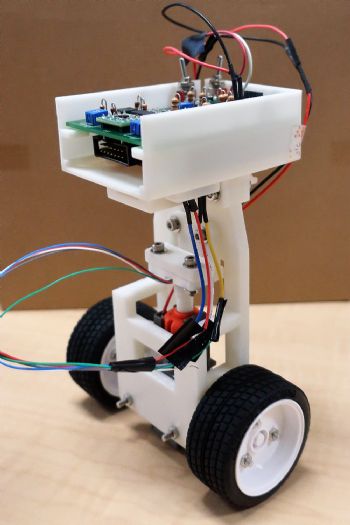
In the design of a self-balancing two-wheeled robotic vehicle, accurate high-speed measurement of angular rotation is a key requirement, as engineering students at Tokyo Denki University can confirm. Jun Ishikaw, a researcher in several technological fields at the University’s Robotics and Mechatronics Department, challenged his engineering students to create a two-wheeled, self-balancing robotic vehicle.
For this project, his students chose the RM08 rotary magnetic position feedback encoder from RLS, an associate company of
Renishaw; based in the UK, it is one of the world’s leading engineering and scientific technology companies, with expertise in precision measurement and healthcare.
Mr Ishikawa’s students had to solve the ‘classic control theory problem’ — the inverted pendulum, which has its centre of mass located above the pivot point and is inherently unstable. One solution, as implemented by Segway, is to mount the pivot point on a wheeled platform. This type of vehicle takes inertial inputs from an IMU (inertial measurement unit) which comprises two sensors: an accelerometer and a gyroscope.
In this case, both vertical-axis and horizontal-axis accelerometers are used to determine the angular acceleration due to gravity. By constantly monitoring the tilt angle and angular velocity of the pendulum, a PD (proportional-derivative) control system can be used to drive the wheels forwards or backwards to maintain balance.
Adopting a similar approach in their own control system, Mr Ishikawa’s students needed to design and integrate what was effectively a three-part solution, comprising tilt-angle sensing, control logic and motor drive circuitry. The PCB control board they developed for this purpose sits at the top of the pendulum, inside the handlebars, and carries all the electronic circuitry required, including a solid-state gyroscope, microcontroller, DC motor drive and power management components.
In the wheeled platform, at the bottom, are two axles: a horizontal axle linking the wheels and a vertical axle driven by a compact DC motor. Simple bevel gearing at the intersection between the axles enables the motor to drive the wheels in either direction.
To maintain balance, the wheels must be driven continuously with carefully calculated acceleration and speed; and to achieve the required level of motion control performance, the students needed a high-resolution position encoder that would monitor and regulate the motor output and be small and light enough to fit within the vehicle’s slim vertical structure — hence the selection of the RM08 rotary magnetic encoder.
This weighs just 2g, including cabling, features an aluminium sensor housing that is 8mm in diameter and just 3mm thick, produces a 12-bit resolution output (4,096 steps per revolution), and is suitable for high-speed operation up to 30,000rev/min while delivering an accuracy of ±0.3deg.